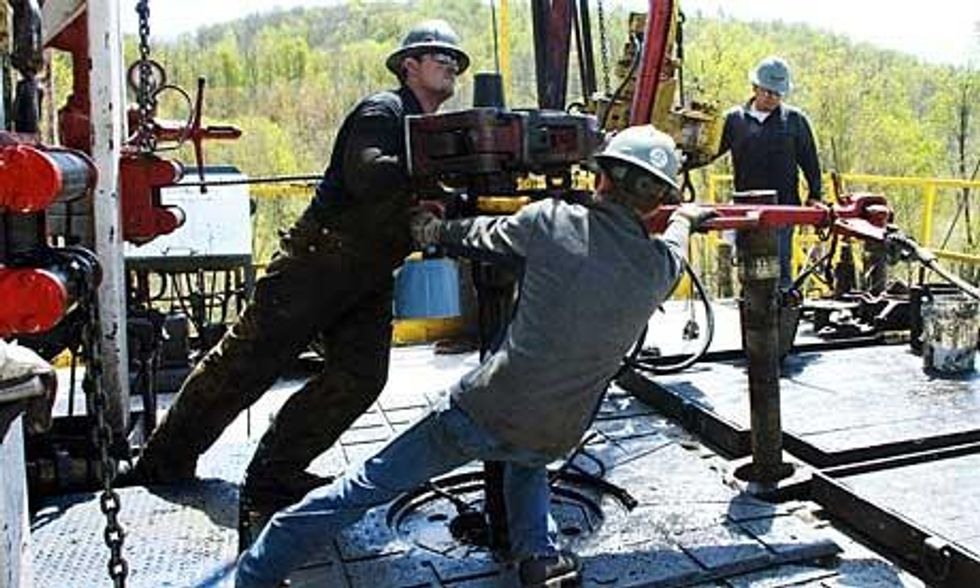Thursday's stunning announcement from US EPA that implicates hydrofracturing ("fracking") as the cause of groundwater contamination in Pavillion, Wyoming is news that has rocked the world. But as groundbreaking and innovative as the investigation has been, the news comes as no surprise to anyone who has been following fracking closely.
Anyone who lives in a gas drilling area can tell you: fracking contaminates groundwater. Citizens have been shouting this at the top of their lungs in fracking areas since shortly after the process of hydraulic fracturing was exempted from the Safe Drinking Water Act in 2005, paving the way for the largest gas drilling boom in domestic history. The exemption, known as the "Halliburton Loophole", allows fracking companies to inject toxic chemicals under the ground in huge quantities and not report it to the EPA. But with this much fracking going on, with thousands of wells being drilled and fracked in 34 states, and with thousands of reported cases of contamination, the gas industry just can't keep their secrets buried; they keep bubbling up through the ground.
Since April 2009, I have been documenting the water contamination in the gas fracking field in Pavillion, Wyoming. The testimony of Pavillion cowboys John Fenton, Louis Meeks and Jeff Locker and their incredible families is some of the most stirring in our film Gasland. Since that time, I have been closely following the extensive three-year EPA investigation, and the results have shown over and over again that there were contaminants in the groundwater, which posed a significant health risk to the residents.
Yet the EPA withheld any language that sounded conclusive - until now. When the whole world is watching, when the gas industry is decrying a lack of science (even as they obstruct and smear the science that has been done), and when the health of the state of New York, alongside significant areas in 34 states and 50 countries worldwide is on the line, you want to make sure that your methods are precise and your statements are conservative.
So, when the EPA now says, "When considered together with other lines of evidence, the data indicates likely impact to groundwater that can be explained by hydraulic fracturing," that is something quite new. What is also clear is that the aquifer in Pavillion will never be cleaned. The contamination there, for the foreseeable future, is permanent. And considering that the permanent contamination of huge areas of groundwater in the US is now a scientifically proven risk, the Pavillion investigation, as extensive as it was, must become the new standard for investigating fracking complaints worldwide.
Having investigated fracking myself for three years, I have heard the same story hundreds of times, from residents in gas-drilling areas from Wyoming to Arkansas, from Pennsylvania to Texas. It goes like this: the frackers move in - and all of a sudden your water turns color, or can be lit on fire, or smells like turpentine or leaves burn marks on you after you take a shower. It doesn't take a genius to connect the dots.
And when reading EPA's water tablature from Pavillion, the notes are really familiar: a minor key refrain of benzene, xylene and other volatile organics, modulation over to glycol ethers and other chemicals in the antifreeze family, a bang-up chorus of thermogenic methane and a killer hook of acetone, naphthalene and 2-butoxyethanol. In fact, three days ago, practically the same list of fracking chemical ingredients found in Pavillion's water were found in water tests from Dimock, Pennsylvania - another poster town for fracking contamination of groundwater.
In Dimock, PA, like Pavillion, citizen's water went bad right after drilling and fracking moved in. Yet, the state agency, PA DEP, and the governor, Tom Corbett, have sided with the gas companies - and they deny any responsibility or long-term harm.
The EPA must intervene in Dimock immediately. An extensive study should be conducted there, with the same careful, methodical and thorough science that was employed in Pavillion. And while that study is conducted, the EPA should mandate that Cabot Oil and Gas supply the residents with replacement water; and the drilling moratorium in the area should continue.
It is hard to prove something that is happening thousands of feet below the ground. It's very difficult and costly, both in time and money. To prove that fracking has contaminated water, even as obvious as it can be to residents who can see the apparent cause and effect, takes extensive and expensive hydrogeological study. Hundreds of chemicals need to be tested over a period of years in a large sample area. In Pavillion, nearly 50 water wells were sampled, two deep monitoring wells were drilled and years of working with the immense pool of data was required. After viewing the EPA draft study (pdf), no one can ever again say that robust science has not been brought to bear on fracking.
But the trail doesn't end there. The gas fracking industry has been so poorly regulated for so long, the legacy of contamination and obfuscation has been allowed to run unchecked for so many years, that the EPA and the United States now faces a Herculean task of investigating the thousands of cases that mirror Pavillion and Dimock - from Texas, to Louisiana, Colorado, Arkansas, Michigan, New Mexico and more.
Beyond the US, Europe, South Africa, China and Australia are right now contemplating embarking on the "shale gas revolution"; they should take note of the EPA's findings. As the story unfolds, the real answer bubbles inexorably to the surface: fracking is deeply flawed; it is inherently contaminating in its present form and must be halted immediately. The empty excuses of the gas industry and the pro-fracking politicians who defend them just don't hold water.


